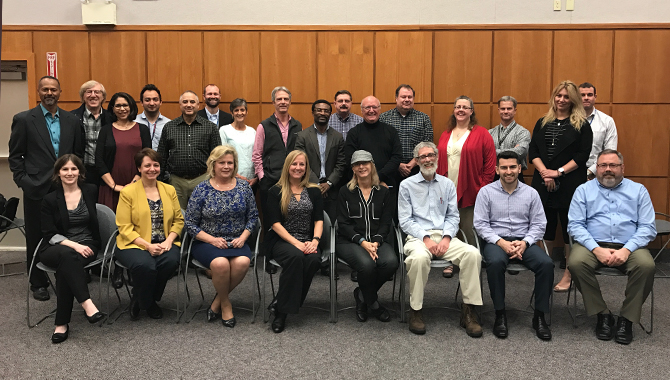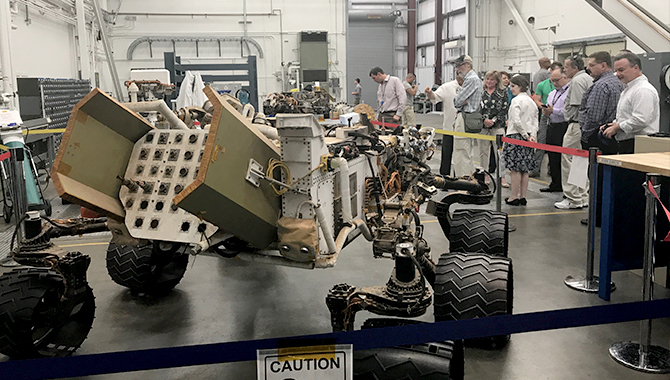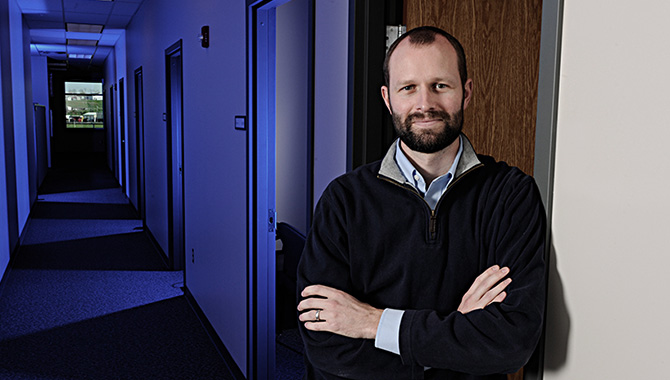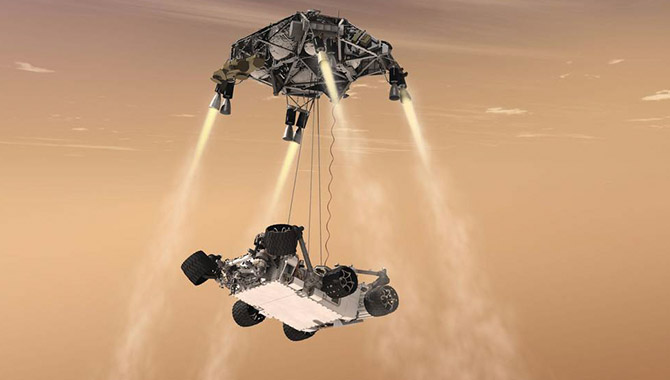
NASA Headquarters OHCM Knowledge Services Lead Billy McMillan.
Photo Credit: NASA
Billy McMillan discusses knowledge sharing in NASA’s Office of Human Capital Management.
Disclaimer: This material is being kept online for historical purposes. Though accurate at the time of publication, it is no longer being updated. The page may contain outdated information or broken links. Current Knowledge Community Corner articles are available here.
Billy McMillan serves as the NASA FIRST (Foundations of Influence, Relationships, Success and Teamwork) Leadership Development Program Manager and Human Innovation Officer at NASA Headquarters Office of Human Capital Management (OHCM) Workforce Engagement Division. McMillan also serves as OHCM’s Knowledge Services Lead. Combining business integration management experience with his passion for organizational development, he supports the growth of future leaders and helps cultivate a new, more innovative way of being for NASA employees.
Prior to joining OHCM, McMillan spent six years working as a Business Integration Manager for the Launch Services Program, managing the majority of the overall budget and also leading agency and Kennedy Space Center (KSC) development and innovation initiatives, including Agency Barriers to Innovation and KSC Innovation Expo. He co-authored KSC’s Innovation Guide, conducted human innovation training, established KSC Launching Leaders as a highly involved employee resource group, and co-authored the KSC Sustainability Plan.
Let’s talk about innovation as it relates to knowledge management and growing the NASA workforce. What are your thoughts and plans on how to make a difference?
I think it starts with creating an experience for people as soon as they come on board to NASA. That gets them to understand what it means to be a NASA employee so it’s almost creating a NASA way of being, one that is more open, connected, vulnerable. Typically, what we’ve seen in the past are these silo effects, not only within centers and organizations, but even with people just holding their stuff to themselves.
We want to offer an onboarding experience that creates the foundation for individuals as they come into NASA, first setting expectations and then working with them and developing them during their first two years. The idea is that we’re taking them from wherever they were and then unfolding them into a more open, vulnerable type of individual so that as they go into the workforce and they’re in meetings and things like that, their way of being creates the environment of more connection and inclusion, which then fosters more innovation.
My definition of innovation is very simple: It’s something different that has impact. So it just truly goes from taking us from where we are now and doing something different with it in order to get an impact. It could be a positive impact. Coming up with an iPhone was a beautiful thing. But also, let’s say an impact was negative. We can still learn from that and we can build upon that to have another innovation or insight. So the onboarding piece, creating a NASA experience, is one piece around innovation.
Another one is just recognizing our own abilities to innovate. Oftentimes we hear that people don’t feel that they are innovative because they aren’t the creative type. It’s fascinating because there’s more to innovation than drawing or thinking of 10,000 ideas in one minute. So we do human innovation training, and what we do at the beginning is identify people’s preferences. They’re a clarifier, an ideator, a developer or an implementer. These are preferences. So you can almost look at it like a Myers-Briggs assessment, where an individual might be an introvert every time they take the test. However, they have the capacity to still be an extrovert, but it’s just their preference to drop into the more introverted style.
If I look at myself, I’m an ideator. I would love to be in that world 100 percent of my time. And I know I have the capacity to implement and to clarify and to develop. So human innovation involves recognizing our own strengths and other people’s strengths, meaning really seeing the value of individuals and not just four different buckets, and then being able to identify what it is you want to work on. If I want to become a better implementer, there are ways to do that. If you find yourself on a team and you’re all ideators and clarifiers, offer up to be the implementer of the group. Put yourself out there and try something new.
Around knowledge management, innovation, to me, is truly being able to strip down everything that we’ve held up in our lives and in our world so that everybody can be not only who we are — the strength, the value that we bring — but also opening up to others and really embracing others and the knowledge and experiences they bring along with them. That can be both personally and within our organization.
What do you see as the biggest challenge to knowledge sharing that has impacted your organization?
The biggest problem is the capture, not so much the sharing. No. 1 is just people not having the time to do it or knowing how to get to a new website to actually put in the content. If it’s not natural to you, if you’re not a blogger or social media type person or newsletter writer, you typically during your day don’t say, ‘Hey, I need to take time to get some content out there.’ You just experience life and you keep going with it being held inside of you. So first, establishing a culture that is willing and open to share is what we’re trying to create so that we can then meet it also from a technology standpoint of actually capturing it in an especially easy, intuitive way.
Are there any successful knowledge efforts in your organization that you’d like to highlight?
One of the innovative things within our office is our intentional focus on the human being and really caring about what’s coming up for each of us at the moment because we change hourly, daily, weekly, and really being in tune with that and caring about it and wanting to know — because it’s easy for us to go about life not caring.
At the end of every meeting we allow individuals to share accomplishments of themselves or acknowledge other individuals for the work they’ve done. So we have a pretty close group here. In our office we’re all in a small area. However, we don’t know what other people are doing all the time. So at every meeting when we’re sharing about ourselves or recognizing other people it allows those insights to come.
I think there’s a caring piece that in itself is innovative. We can say knowledge management, knowledge sharing, but if we don’t care, we’re not going to look at any tool. We’re not going to want to go to these meetings and share our stuff. So it’s really about starting at ground zero and establishing that sense of compassion and caring for each other.
Are you observing any trends or cultural shifts that affect knowledge management going forward?
Something I’m not very happy about is this whole millennial thing. I understand the need for us as human beings to put things in a box because if we name it and we box it up, then it provides a little sense of security and safety — like we know what that is and we can box it — because the unknown is naturally, innately kind of scary for us. We see it like a little caveman — and two tigers are going to jump out at me — kind of thing because it’s different. It’s unknown. So I see that this thing around putting millenials into a box can almost impact relationships and sharing of knowledge. Because the way that people talk about it, it’s almost as if relationships can’t be built between millenials and the older generation and the more experienced workforce. And, in reality, we’re all people.
I saw this beautiful article where this woman took the top 40 things we say about millenials. You know, ‘millennials do blank, whatever it is,’ and she replaced the word ‘millenials’ with ’45-year-old white males.’ And it looked exactly the same. They all had the same characteristics and everything. So it’s like we always put boxes and try to just compartmentalize things in life for our own safety and security because the unknown is very scary.
So what if we finally just stripped away all of that and just truly cared about the relationship and the individual and what they bring to the world. Because then knowledge capture creates more curiosity and this willingness to be surprised with what the other person knows.
What’s the biggest misunderstanding that people have about knowledge?
I will almost say that the biggest misunderstanding is that knowledge is in our head or knowledge is solely things that are tangible specs or inbound words, but there’s a lot of knowledge that is actually in our bodies. And being able to tap into that and express it offers a whole new understanding of what it means to experience something.
So I could tell somebody that I went to this event the other day and learned about innovation. I could tell them that I learned there are four different types of innovators. I could tell them that, which is content from the logical side of the brain. And I could also share more about my body — my experience, my full experience — of the event as far as I was nervous when I heard about the ideator, and how they could almost be annoying to other people, because I know I’m an ideator and I’m curious if other people are annoyed by what I do and the way I interact just because of my passion behind creating ideas. That gives a completely different story, and tells the full story of what it means to actually go through whatever it is.
And so knowledge sharing – knowledge capture — welcomes everything, not only cognitive things that you learn, that you know, that you want to share, but then also this more holistic body aspect to it that can bring a more detailed, well-rounded story that can actually evoke even more reflections for other people to have. Because if I went that level deeper, like if it was just you and me talking, you might identify, ‘Yeah, I’m one of these. I’m a clarifier. And I’m an ideator. Got it.’ But then if I would have held back from sharing my experience of nervousness on how I might annoy other people, then it may not have provoked you to think the same thing. Like, ‘Wow, as a clarifier, what do I do? And how does this almost become my M.O.? And do I want to change it? Or how do I go out and seek feedback?’
It’s almost as if knowledge, yes, it’s the full body because that’s where the whole IQ and the whole experience things come. But knowledge never stops. It’s always evolving. It’s not just a capture — this is where we stand here — because it seems like every topic is changing every second. What I seek to do within the agency, especially within the OHCM community, is to share that knowledge is much more than what we have up in our heads. We live in our heads a lot. And there’s a lot more that we can tap into and express if we actually tap into the body, and then are able to express and communicate it.
Follow Billy McMillan on Twitter @_Billy McMillan









